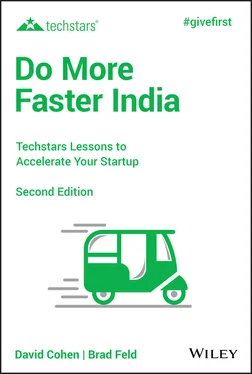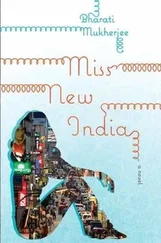Meanwhile, India has witnessed a remarkable transformation of the entrepreneurial ecosystem in that same time frame. In 2005, PayTM started, followed by Flipkart and Inmobi in 2007. Quikr and Yourstory emerged in 2008, MobiKwik and Mydala in 2009, and Ola Cabs, Freshworks, and Snapdeal in 2010. Multiple other startups, like Big Basket and Delhivery, have followed and since 2005, 18 Indian startups reached valuations over $1 billion. Flipkart was purchased by Walmart for $16 billion in 2018, marking the first major exit of an Indian startup.
This list barely scratches the surface of the vibrancy of India’s entrepreneurial ecosystem and we believe that thousands, millions, or tens of millions of Indians with an idea will be creating startups. Many will fail, of course, but we believe the lessons in this book, tested and repeated over a decade, will help startup founders understand what has worked for others and apply those learnings to their own situation.
We believe Techstars can make a significant contribution to the Indian entrepreneurial ecosystem. We have found that by helping entrepreneurs we also help increase employment opportunities and that helps people and communities provide more services and benefits to others. The vast population of India means that Techstars can indirectly impact hundreds of millions of people and communities and elevate the standard of living for many people.
We have also experienced firsthand the incredibly high levels of technical expertise in India, and in fact the technical skills of Indian engineers, computer software developers, and others surpass the levels of skill in other parts of the world. But because of the complexity and diversity of India, the ability to turn superior technologies into marketable products, to develop business models that align with the market, is daunting. That’s where this book and our accelerators come in. The chapters in Do More Faster India highlight the experiences of diverse people who have either participated in our Techstars accelerator program or been a mentor to the program. Some of these people have been wildly successful while others have failed. We think readers can learn something important from both the successful and unsuccessful people. And our hope is that the lessons in this book will motivate entrepreneurs to develop networks and communities and seek out mentors to catalyze India’s entrepreneurial ecosystem.
The challenges in India are significant and unlike any other country in the world. But for Techstars, India is not just one country with limited influence. With its scale, diversity, and constraints, India is a crucible and gateway for five billion people living in emerging economies. The ideas developed in Do More Faster India will work well in other parts of Asia, Africa, and the Middle East. Techstars believes that entrepreneurs create the future, and the future is truly one global family.
Why Entrepreneurs in India Need Techstars
Bala Girisaballa
Bala is president of Techstars India.
The year 2018 was a time of many firsts for the Indian startup ecosystem. A large startup (Flipkart) was purchased for $16 billion by a major corporation (Walmart). India’s homegrown digital payments platform called UPI (Unified Payment Interface), which was launched just two years ago, surpassed American Express’s 500 million global transactions volume.
It’s not surprising that India currently leads in globalization. India‐based companies build technology for leading multinationals across the world and our technology exports alone exceed $126 billion. In 2018, technology contributed 5 percent of India’s $2.5 trillion Gross Domestic Product. Last year, India‐based companies received over $25 billion of investments from venture capitalists and private equity firms. Today, as a result of our educated labor force (three million graduates with one million engineers annually) over 1,200 global corporations have operations in India to leverage the depth and breadth of our technical talent. The investments in technology and substantial employment opportunities with global corporations have provided Indian entrepreneurs experience and exposure to global markets.
The milestones that mark 2018 are ones that I would not have predicted 10 years ago. When I returned to India after working in technology in the United States in 2007, I created a startup. At that time, you could probably fit all the startup founders in a large hall. Being an entrepreneur was something I had to explain to puzzled family members and friends. With no brand name or track record to rely on, it was close to impossible to attract customers. Getting funding or attracting employees for any startup was just as difficult. But from that humble beginning in 2007, the Indian startup ecosystem has blossomed and in the past decade has become one of the top entrepreneurial ecosystems in the world.
While India is quickly becoming a leader in entrepreneurial startups, significant challenges lie ahead. The domestic market is populous, diverse in language, culture, and religion, and largely agricultural. India is home to 1.3 billion people. Our population doubled in a span of 40 years and India added 180 million people, or more than half the US population, in the past 20 years. The scale of this population growth is unmatched everywhere except in China. While the sheer numbers are staggering, the demographic diversity is even more so. India is home to numerous religions, ethnicities, languages, and cultures; 67 percent of India is still rural; 52 percent of the total workforce still relies on agriculture for their livelihood.
Although health outcomes, such as infant mortality and communicable diseases, have improved significantly for Indians, we still have challenges ranging from limited access to healthcare to poor sanitation, and we have an estimated 100 million people at risk of diseases like diabetes. Education also faces significant challenges. Given such a large young population, high dropout rates from high schools rob the potential of millions of students from contributing to society and creating an independent life. Basic necessities, such as access to quality education and good employment opportunities, are critical concerns for local and regional governments. All sectors of India’s economy—energy, agriculture, infrastructure, transportation, manufacturing, finance—face significant scale and structural challenges.
However, these challenges present immense opportunities for entrepreneurs. Until recently the domestic market was beyond the reach of entrepreneurs. The solutions that work in less constrained and simpler markets didn’t work in India. The large population, high rural density, incredible language and cultural diversity, and the vast migration patterns prevent solutions from the United States or Western Europe from being effective in India. But Indian entrepreneurs have one advantage that entrepreneurs in the United States and Europe do not have: the desire by over a billion Indians to seek information and conduct transactions on their smartphones.
The advent of smartphones, with ubiquitous data connectivity and low cost, allows over 500 million Indians to access the Internet. As a result, India is leapfrogging many generations of technology infrastructure. Today India is not just a mobile‐first market but is a mobile‐only market with over a billion mobile subscribers compared to a mere 25 million landline subscribers. While a large percentage of Indian customers may never own a computer or landline, they are connected and accessible. This makes the previously prohibitive and hard‐to‐reach market suddenly open for entrepreneurs to innovate.
India is clearly at an inflection point.
With such a fast‐evolving landscape, building business models that are repeatable and robust is challenging for emerging entrepreneurs. Entrepreneurs comfortable in serving global and urban customers often fail to understand the reality, motivations, and behaviors of customers beyond urban centers. For example, a typical daily wage farmer in a village might have to give up a day’s work and travel over two hours just to reach a bank to deposit money that he would need the very next week. His wife, who makes money weaving clothes in their house, cannot give up a day’s work to go to the nearby town to get her eyes checked. This couple wants to send their kids to school, but good‐quality education and financial means pose big challenges.
Читать дальше












